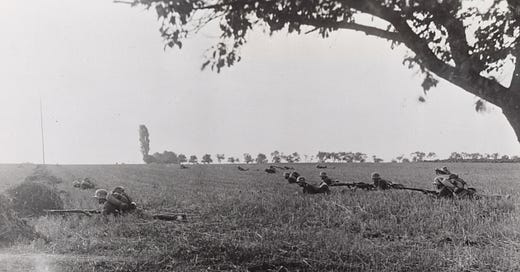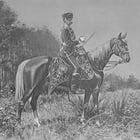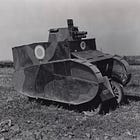Between the end of the First World War and the eve of the Second, the German Army devoted a great deal of attention to an approach to the conduct of campaigns it called ‘delaying resistance’ [hinhaltende Widerstand]. Aimed at preventing an enemy from inflicting a decisive defeat upon Germany before a friendly power could put an end to hostilities, this style of operational maneuver made extensive use of a kind of engagement that the Germans called the ‘delaying fight’ [hinhaltende Gefecht].
The following description of the ‘delaying fight’ comes from a privately published handbook for German soldiers that went through eleven editions in the years between 1920 and 1935.
A delaying fight is any fight that, without leading to a decision, aims to maintain contact with, or deceive, the enemy by means of weakening him systematically and locally or by holding him back for a certain period of time. For the most part, this will consist of defensive operations. However, when the opportunity presents itself, it will include attacks. The delaying fight takes place within a context of inferiority, whether local or temporary, vis à vis the enemy. Thus, it always requires efforts to preserve ones own forces
Units [die Truppe] should make no distinction between delaying [hinhaltende] and decision-seeking [entscheidungsuchende] attacks, between delaying and decision-seeking defensive operations. For them, there is only attack and defense.
It belongs to the senior leadership to determine, by means of the distribution of missions [Auftragserteilung], to use the units in one way or another. If it wishes to attack in a delaying fashion, it will place a forward limit on the attack objective [Angriffsziel]. If it wishes to defend in a delaying fashion, it places the main line of resistance [Hauptkampflinie] in a manner that makes possible a smooth, casualty-free withdrawal.
In the delaying fight, infantry goes into combat gingerly and with deliberation. It fights at long distances, fully using the heavy machine guns assigned to it for that purpose. In order to do this with a little bit of infantry, the infantry in the delaying fight spreads itself out over frontages that are far greater than those needed for decision-seeking attacks or defensive operations aimed at retaining control of terrain. Individual squads, making use of favorable terrain, seek to deceive the enemy.
Early opening of fire with great expenditure of ammunition forces the enemy to deploy prematurely, and so assists this process. Heavy machine guns are employed in large numbers and in great depth. Their positions are chosen so that they can be quickly withdrawn, preferably without the enemy taking notice of that fact. Frequent changes of positions deceive the enemy about our true strength. Light trench mortars [Minenwerfer] act along similar lines.
Strong reserves remain well to the rear. The organization of reserves in depth, and the distances that separate them from the battle front, preserve them from premature employment, and enable them to deal with the changes that take place from time to time in the delaying battle. Sending small detachments forward of one’s own front lines can be of use to hold back the enemy and thus avoid a decisive engagement. These avoid serious fighting along the main line of resistance.
During the delaying fight, the infantry will often use their spades to deceive the enemy. In order to effectively deceive the enemy, special attention must be paid to enemy ground and air observation
Because of its great mobility, great reach, and defiladed positions artillery is of particular value to leaders conducting the delaying fight. Through great expenditure of ammunition during the early opening of fire, it can impede the [enemy’s] achievement of a decision. In particular, artillery can force the enemy infantry to make premature attempts to outflank or envelope our infantry. This, in turn, preserve our infantry from the sort of close contact that might lead to decisive defeat.
In order to deceive the enemy about our own strength, artillery will often operate as two-piece platoons or as single pieces.
Artillery will often, even in the case of long range weapons and at the beginning of the fight, chose positions right behind the infantry in order to engage the enemy as soon as possible. At the same time the artillery should be deeply echeloned in order to easily follow the [rearward] movement of the battle. In order to confuse the enemy, it should change positions frequently and make use of dummy positions.
Rearward positions should be selected with a view to the possibility that [the German] infantry might be forced into a decisive struggle. Forward positions should be reconnoitered in case the delaying fight takes on an offensive character. In order to improve mobility, limbers and horse teams should remain close to the guns.
Source:
Ludwig von Cochenhausen Die Truppenführung: Ein Handbuch für den Truppenführer und seine Gehilfen [The Leading of Formations: A Handbook for the Leader of Large Units and His Assistants] (Berlin: E.S. Mittler & Sohn, 1928) pages 199-200
For Further Reading:










ty o7
Interesting article. I can see the greater dispersion of infantry can also be a great deception in itself, particularly if you believe the opposing force is unsure of your composition. If they are conducing aggressive reconnaissance patrols at night, they will keep bumping into defensive positions that do not match their expectations.